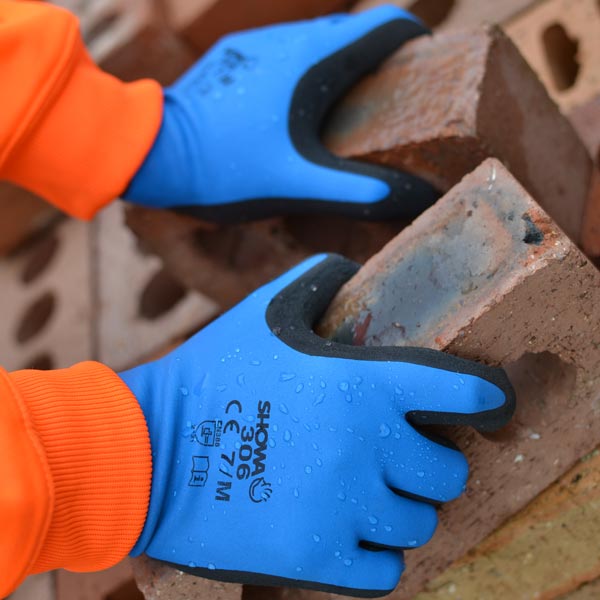HOW TO CHOOSE THE RIGHT WORK GLOVES?

Every worker knows how important it is to choose the right tools for the job, and gloves are one of them. The right gloves can help you achieve your goals and protect you from potential hazards.
Working with the wrong gloves, or without gloves at all, can have negative consequences, ranging from physical injuries to loss of productivity, reduced morale and increased compensation costs.
When choosing gloves, be sure to consider four factors: the hazards to the hands, the task and exposure, the glove material and size.
Identify hazards for your hands
Risks that workers face and what can be avoided with the right gloves include hazardous substances, cuts and tears, abrasions, punctures, chemical and heat burns, and extreme cold and hot temperatures. Identify all hazards. For example, whether there is a risk of abrasion, cut/tear wounds or excessively cold/hot temperatures.
To protect your hands from dangerous substances, choose work gloves that comply with European standard EN16523-1. At the same time, make sure that you choose gloves made of a material that will provide adequate protection against the substance being handled. Chemical-resistant gloves are available that also protect against mechanical hazards (standard EN388) or heat hazards (standard EN407).
Prolonged or constant contact with water, especially in combination with soaps and detergents, may cause skin inflammation. ‘Wet work’ is the term used for work tasks that may cause this skin inflammation. To protect your hands from “wet work”, choose work gloves that comply with European standard EN374-2 – this means that the gloves are waterproof.
Choose gloves according to the hazards you will be exposed to/need protection against and make sure that the gloves offer protection against that particular hazard.
Take into account the task and exposure
The gloves should not hinder or interfere with the work. For example, when working with water or oils, choose gloves with a rougher or patterned surface for a better grip and to prevent objects from falling.
Different situations require different protective equipment. Gloves vary in design, material and thickness. No glove protects against all hazards and no glove will last forever. Take into account whether the gloves will be worn for shorter or longer periods. In the latter case, comfort is important. In general, thicker gloves provide better protection, but thinner gloves are better to work with.
It is also important whether the gloves need to protect against only a few splashes or whether you are working with your hands completely full in a hazardous material. Short gloves protect against individual splashes. If, on the other hand, your hands are in constant contact with dangerous substances, you should choose longer gloves (i.e. the edge of the glove should be longer to prevent dangerous substances from entering the gloves).
What materials are gloves made of?
Work gloves made from proven, reliable materials such as cotton or leather are useful for jobs where there is a risk of cuts, punctures or abrasions.
Working with materials requires flexibility and dexterity, for which gloves made of leather or fabric are best, while also protecting you from potential hazards. Thicker gloves provide better protection, but thinner gloves allow more mobility, so when choosing the right gloves, consider the nature of the work and the potential hazards.
The following is a list of different types of gloves and the hazards they protect against:
- Leather gloves protect against injuries that can be caused by sparks or friction against rough surfaces. Leather gloves with an insulated lining are used in electrical work.
- Fabric gloves are made of cotton or some other cloth material. Fabric gloves have the best grip, so they are used for work involving slippery objects. They also help to protect against mild cold or heat.
- Chemical-resistant gloves are made from materials such as rubber, neoprene, polyvinyl, vinyl, etc. These gloves protect the wearer from corrosive substances, oils and solvents. When choosing chemical-resistant gloves, be sure to take the manufacturer’s recommendations into account, especially if you work with your hands in these substances.
- Gloves with metal mesh protect against cuts or abrasions. They should be worn by people working with cutting tools or other sharp implements.
- Aluminised gloves are made of aluminised fabric and are designed to protect against burns. These gloves should be worn by those working with hot materials.
- Disposable gloves, usually made of vinyl, latex or nitrile, help to protect against mild irritation.
Glove size and fit
If gloves are comfortable, workers are more likely to wear them. Involve your workers in the glove selection process and give them the opportunity to choose their own gloves.
Gloves should be the right size. Gloves that are too small will pinch and gloves that are too big can fall off. Gloves will only protect and be comfortable if they are the right size. A size chart is helpful when choosing:
| Glove Size (standard EN420) | Hand Circumference (mm) | Hand Length (mm) | The minimum glove length |
| 6 | 152 | 160 | 220 |
| 7 | 178 | 170 | 230 |
| 8 | 203 | 182 | 240 |
| 9 | 229 | 192 | 250 |
| 10 | 254 | 204 | 206 |
| 11 | 279 | 215 | 270 |











Follow us on social media:
Join our mailing list! Sign up to receive email updates on new products, special offers and more.